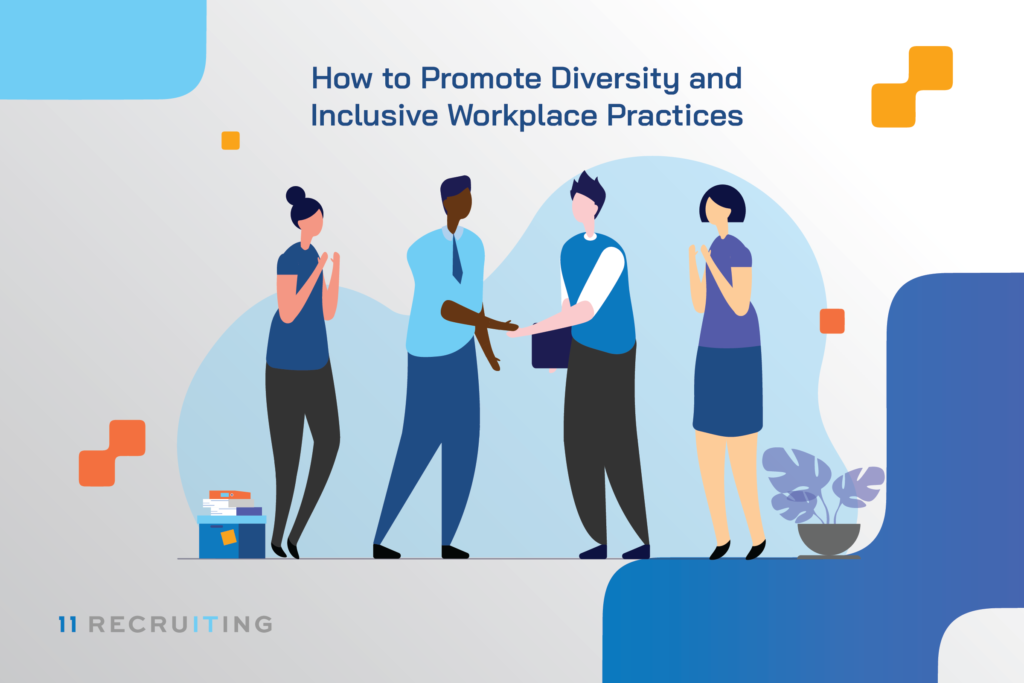
Diversity, equity, and inclusion in the workplace are definitely current buzzwords of this generation. However, despite the shift, the DEI system is still very restricted and is focused entirely on diversity. A diverse workforce is a step in the right direction, but a commitment to promoting inclusiveness and equity is also paramount for the success of any organization.
This post will talk about the progress of DEI initiatives, signs of an inclusive and diverse workplace, and how to promote a more inclusive workplace.
Signs of Diversity, Equity, and Inclusion in the Workplace.
Diversity in the workplace isn’t limited to hiring people of different races, age strata, and gender. There’s more to DE&I than mere recruitment. Another core sign of diversity is the degree to which employee sentiments and capabilities are respected.
For example, generally, older workers with dated skills are inclined to finish the job regardless of work-hour duration whereas younger workers with relevant skills find value in having good work-life balance. A company that values both capabilities and interests is one that promotes a diverse workplace.
Another salient display of diversity, equity, and inclusion in the workplace is a strategic DE&I support system. A company with excellent grievance procedures and equity programs to handle workplace violations and conflicts is a company that effectively practices DE&I. Essentially, a core diversity-fostering infrastructure is one that promotes employees of different color, gender, and age clusters, to team leaders and members of the management hierarchy.
Additionally, employees who belong in marginalized groups need to feel comfortable when voicing out their plight and demands. All of these are telling signs that the company practices diversity, inclusion, and equity.
Progress of Diversity, Equity and Inclusion in the Workplace.
Before now, the typical office setting was a traditional system that didn’t give everyone a chance to fit in. Most organizations used to have a compliance-driven approach towards diversity and inclusion that focused solely on ensuring employees met company goals. With the hit of Covid 19, many organizations treaded towards social consciousness— workplace inclusiveness for diverse employees was no longer an option or a choice. The bliss of remote and hybrid work also helped foster the diversity and inclusive mindsets; no companies are restricting their workforce to a “fitting” narrative.
Society as a whole has also progressed towards adopting a more inclusive paradigm. On June 25, 2021, one of the presidential actions by president Joe Biden was the executive order on Diversity, Equity, Inclusion, and Accessibility in the Federal Workforce. We’re now seeing organizations creating and promoting diversity, equity, and inclusion in the workplace by putting various initiatives in every part of the work cycle— starting from job postings and recruitment stages.
Previously, the credibility market gap was very prevalent due to the absence of concrete action. This led to a more open screening process that enabled positions to become more accessible for people of color, women, and different qualified age groups. The executive order also creates development programs that include diverse talents while making equitable workforce policies.
But this effort is not enough, as DEI isn’t only about putting policies in place. It’s also about the leaders walking the talk to promote diversity and inclusion in the workplace. It’s about making both the dominant group and minority group feel good, heard and supported, and less cynical. Although, with the current political crises, we may experience some backlash to this progress. But it’s hard to deny that the conversation has changed.
Frequently Asked Questions
What are the benefits of diversity and an inclusive workplace?
inclusive workplace practices gives you access to a wide spectrum of unique individuals with unique perspectives and viewpoints that can help grow your organization’s success and better business outcomes.
When employees are aware that they play a crucial part in their work and they feel included at every turn, high levels of employee engagement, commitment, and productivity in their work is likely to occur. More so, it helps companies to stand out with enhanced innovation and reduced employee turnover.
What is the concept behind diversity, equity, and inclusion in the workplace?
Workplace diversity within an organization means the presence of difference in people such as people of color, women, and non-binary individuals in the organization. Inclusion means creating and fostering a welcoming work culture that carries individuals of all identities together, making them feel included and supported.
Equality addresses the barriers that prevent people from accessing the same resources. In essence, all these three facets are independent but complementary.
What happens when you achieve diversity but not equity and inclusion?
Achieving diversity is great because you open the doors of your organization to embracing the different talents from identities with varying viewpoints. But, diversity is not enough. New hires have to feel welcomed or supported in the organization, and to do this, we need equity. Through equity, new hires have access to equal opportunities and resources despite their diversity.
In short, an organization that focuses on diversity should also adapt equity and inclusion into the system.
How to Promote Diversity and Inclusive Workplace Practices
Integrating diversity, equity, and inclusion in the workplace isn’t an overnight process. It’s a long-term and continuous process of practice. So, here are nine tips on promoting diversity and inclusion in the workplace.

It all begins with the support systems
In every organization, the core support systems are HR and leaders. And, these people are the core fundamental aspect in promoting diversity within the organization. Their job is to create and maintain a workplace free of discrimination or inequity. So, go back to the tables, check the current human resources and leadership policies circling diversity, equity and inclusion, develop realistic objectives in decision-making to recognize and cut the existence of conscious and unconscious bias.
Human resources and leaders must also be on board by developing a deep buy-in for DEI initiatives to serve as models and advocates right from the hiring stage.
Have a DEI consultant
Most times, there’s an unconscious bias senior management and human resource teams have towards diversity. If you’ve been trying out diversity initiatives, but it hasn’t been working, consider hiring a diversity equity and inclusion consultant. These professionals work alongside the human resource team during hiring and onboarding as they usually have a strong human resources background focusing on diversifying the workplace.
Aside from recruiting and retaining people from underrepresented groups, DEI expert helps to perform inclusive recruiting that’s focused on the different values, identity-related knowledge, and experiences that can serve as resources to achieve organizational goals.
On-going Inclusive Training
Through ongoing DEI training programs and workshops, employees will remain aware of what it means to be diverse and inclusive. With diversity, equity, and inclusion training, employees get informed about the traditional unconscious bias and ways to tackle them. They are also given clear goals, action-oriented strategies, and updates to help them to achieve those goals.
This training shouldn’t be restricted to employees alone – as you know, DEI starts at hiring and extends to the top of the organizational chart.
Senior management should undergo thorough training regarding inclusive leadership. This training should also include a thorough examination of existing practices at the recruitment phase. Hiring managers should check whether they ask the same questions to all candidates applying for the same role, despite their diversity, and If not, they should prepare a standardized interview structure that captures every applicants’ unique qualifications.
Improve your Harassment and Discrimination Complaints System
Grievance procedures and complaints systems should be in place to help reduce workplace discrimination. For instance, you can impose strict penalties on both leaders and employees who harass coworkers or give offensive remarks toward a particular gender, race, religion, or age group. And if your internal complaint system is causing more harm than good, consider setting up an Employee Assistance Program (EAP) to help you improve the workplace experience when it comes to grievances.
While improving the grievance system, communication should be key. You’ll want to communicate the reason behind the improvement and focus on the positive impacts of diversity and inclusion in the workplace. Otherwise, some employees may misinterpret it as favoritism or tokenism.
Encourage the Use of Inclusive Languages
The language we use can unintentionally leave out a certain group of people or make them uncomfortable. This factor still boils down to whether your company’s culture embraces the unique qualities of individuals. So, one way to promote diversity, equity, and inclusion in the workplace is by encouraging the use of inclusive communication methods that reach all employees through their preferred platform.
The use of politically correct, gender-neutral, and inclusive language is vital, and this should be part of your company’s onboarding and ethics training. The goal here is to help employees increase their sense of community and create an environment where individuals feel welcomed.
Drop the Idea of “Culture Fit” when it has to do with Benefits and Salaries
Look, it’s so impossible for you to have an inclusive workplace with the same mindset of culture fit because it’s hard for someone different to fit into a culture that doesn’t include them. Once you start promoting diversity, equity, and inclusion in the workplace, everything must scream diversity and inclusion, especially salaries and benefits.
No one size fits all, so, what one employee may value might differ from another employee’s values. Also acknowledging the holidays of all the cultures represented in your firm will go a long way in promoting an inclusive workplace.
Invest in a DEI Workspace
Make sure your workspace screams inclusions for all employees by considering the gap between diversity and inclusion. The fact that your organization is fostering diversity by hiring individuals from a range of religious backgrounds, gender identities, or people of color might not mean your workspace is inclusive. For instance, an employee who identifies as lesbian may feel apprehensive about bringing her partner to a company event, or a Muslim who practices daily prayers may feel uncomfortable as there is no quiet or dedicated space to pray.
Your workspace should make your employees feel safe and comfortable being themselves and not segregate them based on any special requirements and needs, especially since that’s the place they spend most of their day. Doing this will help to create a sense of connection, increase employee satisfaction, and also improve recruitment and retention.
Always Ask Questions
One of the best ways to promote diversity, equity, and inclusion in the workplace is to hold an open conversation with employees and capture their feedback about diversity, equity, and inclusion. Allowing employees to share their authentic perspectives helps to create spaces to come together and feel safe and supported. With their feedback, you’ll be able to understand how they feel, and what you can do to reshape workplace policies, values, and behavior.
It can also help you track the success of new policies and install changes to stay on track. To get the most out of your feedback, you can create surveys and segment the data based on the factors like gender, people of color, age, and more. Doing this will help you spot the specific concerns within each group and to be able to come up with better soothing policies.
Be Consistent
Succeeding in creating diversity, equity, and an inclusive workplace is a continuous process that should be evolving every day— no one shoe fits all. Track and analyze the progress of your company’s D&I initiative to check for ways to improve. There is no right way or one way to know for sure if your idea of diversity, equity, and inclusion is correct— there is no standard. Organizations can also explore other DE&I that work for them based on their organizational and employee structure and their personality.
Think you know how to differentiate between a company that prioritizes DE&I? Head over to our candidate services page to get a good glimpse of what we do and how we make things work for employees in all walks of life!

